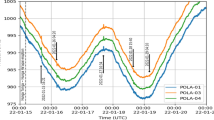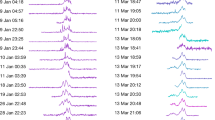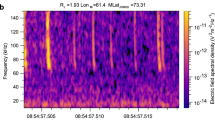Abstract
The scintillation of celestial radio sources due to small-scale turbulence along lines of sight through the interplanetary medium provides a convenient, ground-based method of monitoring disturbances in interplanetary space. With the sensitive 3.6-hectare Array at Cambridge we have carried out a new programme in which ∼900 sources were observed each day for more than 1 yr. When the long-term average scintillation behaviour of each source had been accurately determined we found that transient disturbances could be clearly distinguished. We detected large clouds of enhanced turbulence moving out from the Sun and were able to track them to distances beyond the Earth's orbit. Our observations differ from recent work elsewhere1 in that we used a larger grid of sources and observed them more continuously over a wider range of solar elongations. To illustrate the information that is now being obtained we present observations for 10–21 December 1978, a period of considerable solar activity for which spacecraft and other data are also available.
This is a preview of subscription content, access via your institution
Access options
Subscribe to this journal
Receive 51 print issues and online access
$199.00 per year
only $3.90 per issue
Buy this article
- Purchase on Springer Link
- Instant access to full article PDF
Prices may be subject to local taxes which are calculated during checkout
Similar content being viewed by others
References
Vlasov, V. T. Astr. Z. 56, 96–105 (1979).
Duffett-Smith, P. J., Purvis, A. & Hewish, A. Mon. Not. R. astr. Soc. 190, 891–901 (1980).
Readhead, A. C. S. Mon. Not. R. astr. Soc. 155, 185–197 (1971).
Readhead, A. C. S., Kemp, M. C. & Hewish, A. Mon. Not. R. astr. Soc. 185, 207–225 (1978).
Burlaga, L. F. Space Sci. Rev. 23, 201–216 (1979).
Smith, E. J. & Wolfe, J. H. Space Sci. Rev. 23, 217–252 (1979).
Houminer, Z. & Hewish, A. Planet. Space Sci. 22, 1041–1042 (1974).
Erskine, F. T., Cronyn, W. M., Shawnan, S. D., Roelof, E. C. & Gotwols, B. L. J. geophys. Res. 83, 4153–4164 (1978).
Kakinuma, T. & Watanabe, T. Space Sci. Rev. 19, 611–627 (1976).
Rickett, B. J. Solar Phys. 43, 237–247 (1975).
Ananthakrishnan, S., Coles, W. A. & Kaufman, J. J. J. geophys. Res. 85, 6025–6030 (1980).
Sheeley, Jr. N. R. & Harvey, J. W. Solar Phys. 70, 237–249 (1981).
Intriligator, D. S., Dryer, M. & Tandberg-Hanssen, E. (eds) Solar and Interplanetary Dynamics (Reidel, Dordrecht, 1980).
Wolfe, J. H. et al. Science 203, 750–752 (1979).
Author information
Authors and Affiliations
Rights and permissions
About this article
Cite this article
Gapper, G., Hewish, A., Purvis, A. et al. Observing interplanetary disturbances from the ground. Nature 296, 633–636 (1982). https://doi.org/10.1038/296633a0
Received:
Accepted:
Issue Date:
DOI: https://doi.org/10.1038/296633a0
This article is cited by
-
Interplanetary Scintillation Observations of Solar-Wind Disturbances During Cycles 23 and 24
Solar Physics (2023)
-
East–West Asymmetry in Interplanetary-Scintillation-Level Variation Associated with Solar-Wind Disturbances
Solar Physics (2023)
-
Validation of coronal mass ejection arrival-time forecasts by magnetohydrodynamic simulations based on interplanetary scintillation observations
Earth, Planets and Space (2021)
-
Development of a coronal mass ejection arrival time forecasting system using interplanetary scintillation observations
Earth, Planets and Space (2019)
-
History and development of coronal mass ejections as a key player in solar terrestrial relationship
Geoscience Letters (2016)
Comments
By submitting a comment you agree to abide by our Terms and Community Guidelines. If you find something abusive or that does not comply with our terms or guidelines please flag it as inappropriate.



